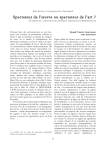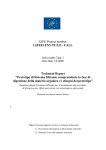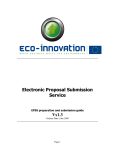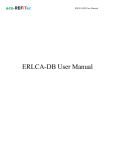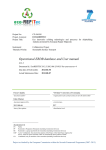Download Eco-Innovation User-guide - Enterprise Europe Network
Transcript
Competitiveness and Innovation Framework Programme Eco-Innovation User Guide Table of contents: 1. Promoting eco-innovation 2. Eco-innovation in CIP 3. CIP eco-innovation and other EU programmes 4. Instruments for eco-innovative SMEs 1. Promoting eco-innovation It is now clearly acknowledged that eco-innovation and environmental technologies are instrumental to attain a number of environmental objectives, such as pollution reduction, reduction of greenhouse gases and promoting new patterns of production and consumption. Promoting technologies and innovation that are "good for business and good for the environment" is on the increase. In 2004, the Environmental Technologies Action plan (ETAP)1, has set into motion a range of activities both at EU and Member State level. This however, only marks the beginning. The application of environmentally friendly technologies and innovations has to demonstrate benefits and results in terms of CO2 reduction, reduction of water consumption, increase in quantity of recycled materials, and many more. In addition, these actions must make economic and business sense and demonstrate tangible benefits in terms of investments, turnover, market penetration and SME creation. There are many technological and business innovations already in place that can significantly benefit the environment and have proven track record. The challenge now is to provide new driving forces that will encourage the diffusion and take-up of eco-innovation on a broad scale, maximising their economic and environmental benefits. 2. Eco-innovation in the Competitiveness and Innovation Programme The Competitiveness and Innovation Framework Programme (2007-2013)2 or CIP has a budget of EUR 3 621 million and a range of actions supporting innovation and Small and Medium Enterprises (SMEs)3. Eco-innovation as a cross-cutting issue through three subprogrammes: Entrepreneurship and Innovation, Information and Communication Technologies, and Intelligent Energy Europe. Within the sub-programme ‘Entrepreneurship and Innovation’, EUR 433 million (out of 2 172 million) are earmarked for specific support actions on eco-innovation. The text of the CIP decision introduces eco-innovation as follows: eco-innovation is any form of innovation aiming at significant and demonstrable progress towards the goal of sustainable development, through reducing impacts on the environment or achieving a more efficient and responsible use of resources, including energy. Eco-innovation is a progressive concept: the CIP programme must remain responsive to changes. 1 COM(2004) 38 final, of 28 January 2004 'Stimulating Technologies for Sustainable Development: an Environmental Technologies Action Plan for the European Union'. 2 Decision No 1639/2006/EC of the European Parliament and of the Council, of 24 October 2006 establishing a Competitiveness and Innovation Framework Programme (2007 to 2013) 3 Commission Recommendation 2003/361/EC of 6 May 2003 Eco-innovation will be supported through three types of measures: • financial instruments (in particular the support to investment funds active in ecoinnovation) with an indicative budget of € 228 million (2007-2013), • networks of national and regional actors , with an indicative budget € 10 million and • pilot and market replication projects, with an indicative budget € 195 million. 3. CIP eco-innovation and other EU programmes The CIP programme contributes to the 7th Framework Programme for Research and Technological Development4 (FP RTD). CIP eco-innovation aims to foster the competitiveness of enterprises and promote eco-innovative, market oriented activities which benefit to the environment. The environmental component of the 7th FP RTD focuses on research, development and demonstration. In order to avoid any overlap, CIP concentrates on the techniques, products or practices whose technical performances and economic feasibility have already been validated, but which have not yet been commercialised largely because of remaining risks or the need to adapt these technologies to new geographical or economic conditions. Concerning other programmes with environmentally objectives, such as Structural and Cohesion Funds5, actions financed under CIP eco-innovation can serve to reinforce and/or prepare the way for actions within such programmes. LIFE+ Environment Policy & Governance6 aims specifically at implementing, updating and developing the Community environmental policy and legislation, thereby contributes to sustainable development. LIFE+ aims to bridge the gap between research and development results and widespread implementation. The programme supports innovative solutions that have a public dimension (ex: organisation of waste collection on the given territory, processes related to the mixed urban waste etc). LIFE+ will therefore mainly apply to projects that actively aim at the dissemination of environmental solutions by public actors or (private actors having a mission of general interest), so the participation of public authorities at regional or local level will be particularly encouraged. On the other hand, CIP refers to market oriented activities related to the take up of the environmental technologies and eco-innovative activities by enterprises and oriented towards 4 : http://ec.europa.eu/research/fp7/index_en.cfm 5 6 http://ec.europa.eu/regional_policy/funds/prord/prord_en.htm Regulation (EC) No 614/2007 of the European Parliament and of the Council of 23 May 2007 concerning the Financial Instrument for the Environment (LIFE+) commercialisation of innovation on the competitive market. CIP will also encourage proposals by entrepreneurs who promote new or integrated approaches to eco-innovation, such as environmental management, environmentally friendly design of products, processes or services7. Proposals may be submitted by all legal entities established in the Member States of the European Union, however the CIP will particularly encourage proposals by Small and Medium-sized Enterprises. 4. Instruments for eco-innovative SMEs 4.1. Financial instrument The financial instruments aim at facilitating the access of SMEs to commercial-type funding, such as risk capital or bank loans, in order to address a crucial factor in the development of innovative companies or companies with a high growth potential. €228 million is earmarked for period 2007-2013 to support SMEs, through two instruments: the High Growth and Innovative Company Facilities (GIF 1 and GIF 2), and the Capacity Building Scheme (CBS). This means that around € 30 million will be available yearly for investment into the eco-innovative Small and Medium-Sized companies. GIF instruments allow for the Community participation in risk capital funds established to provide equity to SMEs in the seed or early development phase (for GIF 1) or in their expansion phase (for GIF 2). A higher participation is allowed for risk capital funds whose main focus is on eco-innovation. The GIF instruments will be implemented by the European Investment Fund (EIF) on behalf of the European Commission. The Capacity Building Scheme (CBS) aims at improving the financial and technical expertise of financial intermediaries investing in SMEs or supplying credit to SMEs. This includes: • the Seed Capital Action, supporting the recruitment and training of additional financial or technology experts (including experts in eco-innovation) in risk capital funds, and • the Partnership Action, providing technical assistance to financial institutions in the new Member States, in order to stimulate the supply of credit to SMEs for eco-innovative activities. The CBS will be implemented by international financial institutions on behalf of the European Commission. 7 For example, if a proposal relates to the application of EMAS or Eco-label by an individual enterprise or a group of enterprises it should be submitted to CIP. If the projects relates to the application (at an EU level) of EMAS or Eco-label by a public body, to development of the policy or to a measure aimed at the whole sector rather than individual enterprises it is eligible for LIFE+ funding. For more details on financial instruments available for support of eco-innovation please refer to the following website. (under construction) 4.2. Networking CIP will support networks active in the field of eco-innovation through: • mobilising, networking and supporting national or sub-national innovation programmes to exchange information and good practices, analyse common strategic issues and possibly develop joint activities, or • supporting specific actions or services offered by national innovation actors (such as innovation agencies), in order to allow for common services or the reciprocal opening of national measures to enterprises located in other Member States. In years 2008-2009 the programme will encourage proposals that lead to: • • Establishing a Knowledge Resource on Eco-innovation, in the form of a networked observatory. The network will provide essential and up-to-date analyses of environmental technology and eco-innovation markets, including statistics by country and by market segment. In addition to such market studies, special studies on topics of particular interest and, last but not least, an overview of the latest innovative, technological and financial developments. 'Championing Eco-innovation' through the dissemination of promising practice examples across Member States. The aim of the network will be to explore ways of further knowledge dissemination and communication of the promising eco-innovative activities and facilitating the replication of good practices in Member States. Total budget for years 2007-2013 is € 10 million. In years 2008-2009 circa €5 million should be made available. The detailed CIP eco-innovation Work Programme will be published by the end of the year 2007. 4.3. Pilot and Market Replication Projects Barriers to the market penetration of innovative technologies are particularly important for environmental technologies. Therefore CIP eco-innovation will support projects: • concerned with the first application or market replication of eco-innovative techniques, products or practices, which • have already been successfully demonstrated, but • due to remaining risks need incentives to significantly penetrate the market. Supporting such promising innovative eco-technologies should contribute to remove the obstacles to the development and wide application of eco-innovation, create or enlarge markets for related products and improve the competitiveness of EU enterprises on world markets. The following aspects of pilot and market replication projects will be assessed in particular: • Innovative character of the project, presenting clear and substantial environmental benefits and supporting Community policy objectives; • Potential for replication of the eco-innovative technology, potential to create or enlarge markets or to improve the competitiveness of EU economy; • Quality of the technical and economic performances already demonstrated by the product, processes, service or method, quality of the proposed dissemination of project results; • Soundness and coherence of the project, from a financial and project management point of view; soundness of participants and (if appropriate) coherence of the partnership proposed. The detailed operational procedures for selecting and supporting projects are presented in the documents supporting implementation of CIP eco-innovation, to be published on the webpage of the Executive Agency for Competitiveness and Innovation. The general principles, detailed in the operational procedures, include: - the support will take the form of grants off-setting part of the cost of projects - the selection and monitoring of projects will be implemented by the Executive Agency for Competitiveness and Innovation. - there will be no obligation of partnership involving partners from different Member States, but partnerships and international activities coherent with the project objectives will be an advantage. - involvement of Small and Medium Enterprises in projects is encouraged and will be an advantage in the selection of proposals. Priority areas CIP will support eco-innovative products, services or production processes which aim at the prevention or reduction of environmental impacts or which contribute to the optimisation of resources use. The priority areas for CIP eco-innovation are as follows: (a) Cleaner production processes in all industrial sectors, with a preference for those sectors having an important environmental impact, such as construction, chemicals, food and drink industry, manufacturing, recycling or metal processing. Projects focused on energy production and energy efficiency shall be directed towards CIP Intelligent Energy Europe while those related to freight transport shall be directed towards Marco Polo programme. (b) Innovative environmentally-friendly products and services, including innovative approaches to the design of products and to the information or labelling on the environmental performance of products (c) Support to enterprises (especially SMEs) in greening their business, products and management methods - especially innovative approaches to environmental management systems For the overview of the eco-innovative projects financed under the former LIFEEnvironment programme please refer to the webpage. The examples from the programme presented below related to cleaner technologies or innovative products or services are potentially relevant for CIP. The examples are for information only and do not in any sense indicate the future priorities for CIP eco-innovation. 1) Eco-innovative product: VAPO- (reference: LIFE03 ENV/D/000031) The aim of the project was to develop a burner system, working for oil burners in a range of 2-20 kW (especially for private households), that offers energy saving of at least 5% compared to the current best available oil-burning technology. The system was also designed to reduce CO emissions to one third of those produced by the current systems and to completely eliminate soot emissions. Additionally, a significant noise reduction and heavily reduced NOx emissions are expected. These factors, together with its high efficiency homogenous combustion field and high modulation range, could set a new standard in oil combustion. As a result of the project, a modernisation push is expected in a market of 500k oilcondensing boilers inside the EU. 2) Cleaner production process: CLEAN DECO- (reference: LIFE00 ENV/IT/000213) Amongst the coating processes used in the decorative field, in particular in chromiumplating treatment in tap production, galvanising technology is the most widely used. This kind of technology is very polluting, both in the preparation phases and in the galvanising process itself. The project is aimed at providing the SMEs in the sector with an alternative economically viable and clean technology in place of the current galvanising chromium-plating treatment. The new cleaning process is based on a recyclable cleaning liquid; the liquid is recycled by a resin, which is the only waste after its exhaustion. The drying process is based on a thermal vacuum process, which generates no waste. The technology replacement can provide environmental and economic advantages, such as: sensible reduction of chromium content in waste waters, toxic solid waste (sludge) and gas emissions; sensible reduction of dangerous raw material (chromium anhydride); sensible reduction in energy consumption and water use; better quality of the coating compared to the galvanised one. 3) Support for enterprises: Shipping with EMAS (reference: LIFE03 ENV/IT/000393) The objective of this project is to develop innovative methods for the environmental management of shipping companies and to support the implementation of the EMAS regulation in shipping companies. The project aims at identifying best practice and lead to the development of a methodological model and technical manual with specific tools for implementing Eco-Management and Audit Scheme. Co-financing rates The financial contribution under CIP eco-innovation takes the form of a grant off-setting part of the eligible costs of the project, under the following maximum rate: 40 % if the benefiting company is a large enterprise; 50 % if the benefiting company is a medium enterprise; 60% if the benefiting company is a small enterprise; 50% if the project is run by a not-for-profit organisation and does not involve industrial or commercial activities. If the project involves industrial or commercial activities, the rules governing the funding from CIP follow the Community guidelines for State aid for environmental protection. This includes in particular: Costs eligible for funding should correspond to the extra investment costs necessary to achieve a level of protection higher than the level required by the Community standards, and should be directly related to the innovative technique or method proposed. Eligible costs must be calculated net of any operating benefits and costs incurred during the first five years of the life of the investment. If the project receives funding from other public sources of funding, their contribution should be deducted from the maximum rate indicated above, which applies to the sum of all public funding. If the project does not involve industrial or commercial activities, the total cost of the project may be considered eligible, with the exceptions listed below. Eligibility of costs Applicants should avoid presenting to CIP eco-innovation any costs related to the following activities or items since they are considered ineligible for financing: land purchase or any other related costs; studies not specifically addressing the objective stated in the financed proposals; investments in major infrastructure or investments of a non-innovative nature, including activities already confirmed on an industrial scale; research and technological development activities; land remediation costs, which are subject to the polluter-pays principle; any cost incurred for action which benefits from aid under other Community financial instrument To be considered eligible, costs must: be provided in the provisional budget of the proposal, be directly linked to and necessary for carrying out the proposal covered by the decision. personnel costs shall be charged in respect of the actual time devoted to the project. be technically and financially coherent and feasible and providing value for money , be actually incurred during the lifetime of the proposal, as defined in the grant agreement, and be recorded in the beneficiary’s and eventual partners’ accounts or tax documents, and be identifiable and controllable. overheads shall be eligible for flat-rate funding of 7% of the total amount of eligible direct cost and are intended to cover general indirect costs needed to employ, manage, accommodate and support directly or indirectly the personnel working on the project












